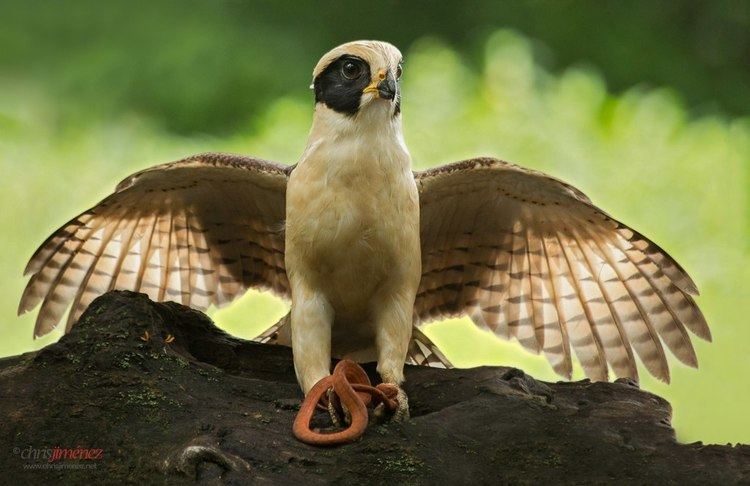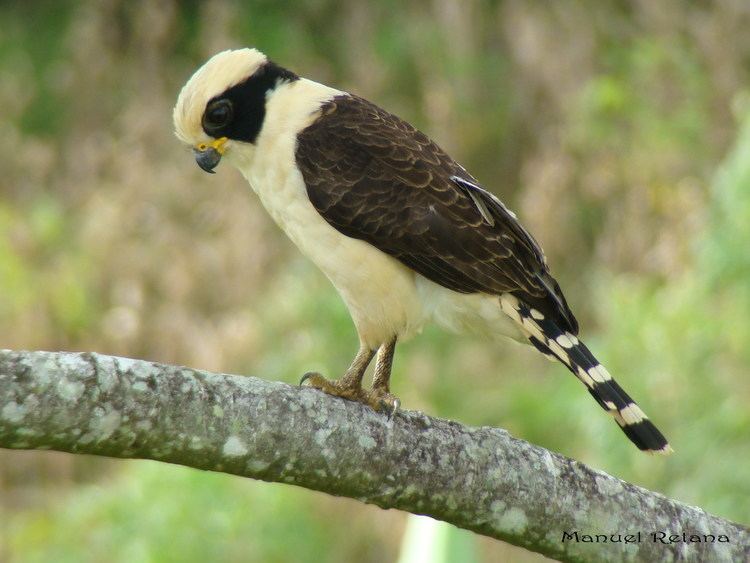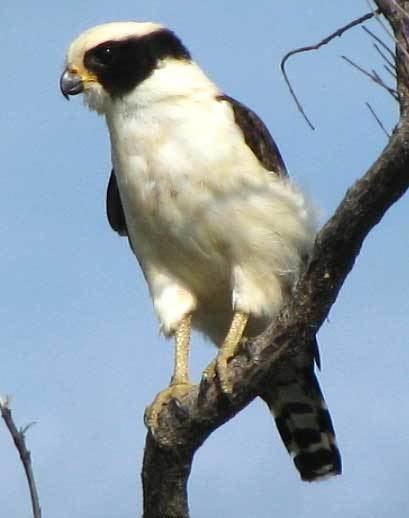Order Falconiformes Scientific name Herpetotheres cachinnans Rank Species | Phylum Chordata Higher classification Herpetotheres | |
Genus HerpetotheresVieillot, 1817 Similar | ||
The laughing falcon a specialized snake killer
The laughing falcon (Herpetotheres cachinnans), also called the snake hawk (erroneously, since it is not a hawk), is a medium-sized bird of prey in the falcon family (Falconidae), the only member of the genus Herpetotheres. This Neotropical species is a specialist snake-eater. Its common and scientific names both refer to its distinctive voice.
Contents
- The laughing falcon a specialized snake killer
- Laughing falcon herpetotheres cachinnans
- Taxonomy
- Description
- Voice
- Distribution and habitat
- Behaviour
- Feeding
- Breeding
- Culture
- References

Laughing falcon herpetotheres cachinnans
Taxonomy

Its English name comes from its loud voice, as does the specific name cachinnans, Latin for "laughing aloud" or "laughing immoderately". The generic name Herpetotheres refers to its preferred food; it is Latinized Ancient Greek, derived from [h]erpeton (ἑρπετόν, "reptile") + therizein (θερίζειν, "to mow down").

Its relationships with other members of the Falconidae are unclear. Traditionally it has been placed in the subfamily Polyborinae with the caracaras and forest falcons, but the American Ornithologists' Union's North American Check-list Committee now places it in the same subfamily as the true falcons, while the South American Check-list Committee places it with the forest falcons but not the caracaras, and it has also been considered a subfamily of its own.
Description

The laughing falcon is 46 to 56 cm (18 to 22 in) long and has a wingspan of 79 to 94 cm (31 to 37 in). As usual among birds of prey, the females are bigger, weighing 600 to 800 g (1.3 to 1.8 lb) compared to the males' 410 to 680 g (0.90 to 1.50 lb).
Adults have a pale buff head, changeable between a more brownish and an almost white hue according to feather wear and individual variation. The broad black face mask stretches across the neck as a narrow collar, bordered with white. On the crown, the feather shafts are dark, producing a somewhat streaked effect. The upper wings and back are blackish brown. The uppertail coverts are whitish buff again, and the rectrices are barred black and whitish, ending in white. The underside is uniformly pale buff; there may be a bit of dark speckling on the thighs, however. The underside of the wing is pale rufous-buff, sometimes with some dark spotting on the underwing coverts. The tips of the primary remiges are barred with pale grey below, their bases are quite rufous. The iris is dark brown, the bill is black with a pale yellow cere; the feet are also pale yellow.
Immature birds differ little from adults; they have lighter margins to the back feathers, producing a scalloped effect. The light parts of the plumage are almost white, paler than in adults; the unfeathered parts are also paler. Nestlings are covered in peculiarly dense down, reminiscent of a duckling's; they are generally brownish buff, darker above, and already show the blackish facial marks of the adults.
With its big white (immature) or pale buff (adult) head having a dark brown mask from the eyes around to the nape, it is unmistakable. In flight it shows a rufous patch near each wingtip (formed by the basal parts of the primaries) and a shape more like an Accipiter hawk than most of its falcon relatives, with short, rounded wings and a long tail.
Voice
The namesake call is a long series of separate, rather human-like cries, each one often rising sharply in pitch in the middle and sometimes falling sharply at the very end, changing from a "joyful" to a "sad" sound, and rendered as ha-ha-ha har-her-her or haww harr herrer. The series may be introduced by faster hahahahahaha calls suggestive of maniacal laughter, particularly when the bird is startled. Sometimes two birds call together at different pitches and tempos, producing a striking off-beat effect.
The laughing falcon has another call, typically given at dusk. This two-note call is preceded by a series of gwa notes given every half-second or so. They become more emphatic and after some time change to a sequence of the gwa co call proper, with the first syllable higher in pitch than the second, but not differing in emphasis or volume. The gwa co call may be repeated 50 times or more. Sometimes, the initial calls are a oo oo-oo cow-cow-cow, sometimes a descending gwaaaaaaa..... On occasion, the two-syllable call is not given, and instead the simple gwa is repeated as often as the full call.
The familiarity of these sounds in the American tropics is attested to by such common names as acauã (Portuguese), halcón macagua, guaco, halcón guaco, and guaicurú (Spanish), and guaycurú (Guaraní).
Distribution and habitat
It is found from both coastal slopes of Mexico through Central and South America south to the Peruvian Amazon and Bolivian Amazon region, practically all of Brazil, and northern Argentina and Paraguay, at altitudes up to 1,500 m (4,900 feet) (rarely to 2,400 m (7,900 feet) in Colombia), though it is often absent from mountainous regions. It occupies varied habitats, usually including at least scattered trees; it prefers humid regions to arid ones and tends to avoid closed forest. It is generally not migratory, though in some areas it may make seasonal movements.
Behaviour
The flight is slow, with quick, shallow wingbeats interspersed with glides; the bird rarely if ever soars. When it lands, it will jerk the tail forcefully just like a wagtail. A laughing falcon frequently and often conspicuously stays on a perch for hours, sitting upright and observing the ground alertly, sometimes flicking its tail or nodding, or moving around a bit on its perch with slow, cautious little steps. It is generally peaceful and unlike other falcons will not harm smaller birds.
Feeding
It catches mainly snakes, including venomous ones such as coral snakes, and also lizards, and, to a lesser extent, small rodents, bats and centipedes. The laughing falcon pounces on its prey from flight, often with an audible thud, and then biting it just behind the head, sometimes removing the head in the process. It carries the food to a perch to eat. It may carry small snakes in its bill and swallow them tail-first; big snakes may be carried head-forward in its claws, as an osprey carries a fish, and then torn to pieces.
Breeding
The laughing falcon breeds in rock crevices, tree cavities, or occasionally in abandoned nests of a Buteo hawk or caracara; in general however it does not even gather nesting material in significant quantities. It lays one or two eggs according to some sources, but according to others always just one. The eggs have heavy dark brown markings on a brown or whitish or pale buff background. The young are thought to leave the nest eight weeks after hatching.The breeding season has been given as April and May, though it may well vary across the large range of this species.
Culture
The Ch'ol Maya of Chiapas, Mexico believe that the laughing falcon can kill poisonous snakes because the birds are healers that can cure themselves if they are bitten. Tzotzil healers imitate the call of a laughing falcon in order to cure a snake bite.
